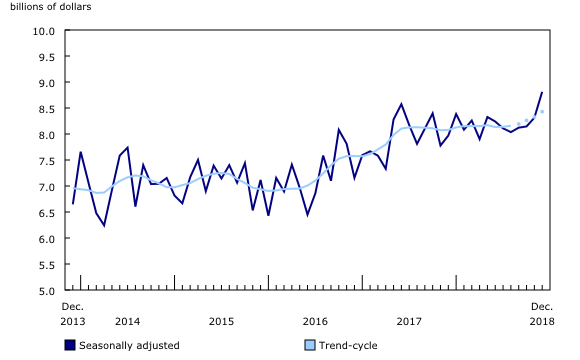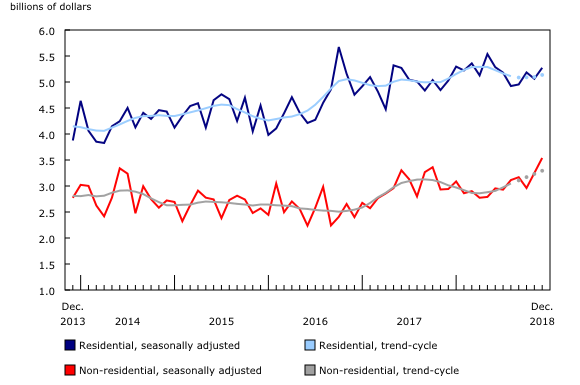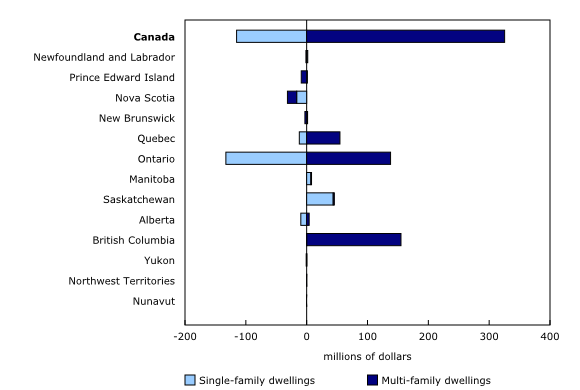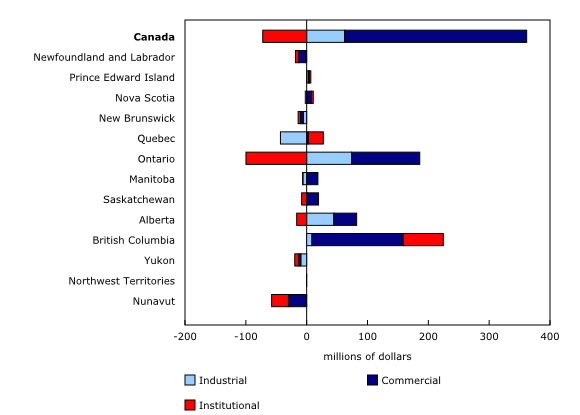Building permits, December 2018
Archived Content
Information identified as archived is provided for reference, research or recordkeeping purposes. It is not subject to the Government of Canada Web Standards and has not been altered or updated since it was archived. Please "contact us" to request a format other than those available.
Released: 2019-02-06
$8.8 billion
December 2018
6.0% 
(monthly change)
$19.7 million
December 2018
-47.5% 
(monthly change)
$34.0 million
December 2018
-2.7% 
(monthly change)
$120.6 million
December 2018
-16.0% 
(monthly change)
$72.5 million
December 2018
-17.6% 
(monthly change)
$1,800.8 million
December 2018
1.5% 
(monthly change)
$3,072.1 million
December 2018
3.1% 
(monthly change)
$238.4 million
December 2018
9.1% 
(monthly change)
$203.7 million
December 2018
38.5% 
(monthly change)
$1,131.7 million
December 2018
5.6% 
(monthly change)
$2,108.4 million
December 2018
22.0% 
(monthly change)
$8.5 million
December 2018
-70.5% 
(monthly change)
$1.6 million
December 2018
-0.6% 
(monthly change)
$0.0 million
December 2018
-100.0% 
(monthly change)
Canadian municipalities issued $8.8 billion worth of building permits in December, up 6.0% from November and the fourth consecutive monthly increase. The gain was largely due to higher construction intentions for multi-family dwellings and commercial buildings, with both components hitting record highs.
Residential sector: Higher construction intentions for multi-family dwellings
The value of residential building permits was up 4.2% in December to $5.3 billion. Six provinces posted increases, led by British Columbia.
In the multi-family dwelling component, the value of permits rose 11.1% to a record high $3.3 billion, marking the fourth consecutive monthly increase. Six provinces reported gains, led by British Columbia (+$155 million) and Ontario (+$138 million).
The value of building permits for single-family dwellings was down 5.4% to $2.0 billion. Four provinces posted declines, most notably Ontario, which reported its lowest value since March 2014.
In December, municipalities approved the construction of 20,210 new dwellings (+2.9%), consisting of 15,678 multi-family units (+5.0%) and 4,532 single-family units (-3.6%).
Non-residential sector: Commercial and industrial components increase
The value of building permits issued for non-residential structures rose 8.9% in December to $3.5 billion. Increases were reported in seven provinces, most notably British Columbia.
In the commercial component, the value of permits rose 14.6% to a record high of $2.3 billion in December. Eight provinces recorded advances, led by British Columbia (+$150 million) and Ontario (+$112 million).
The value of industrial building permits was up 11.9% to $588 million, mainly as a result of higher construction intentions for maintenance buildings.
In contrast, the value of institutional permits fell 10.6% to $606 million, the third consecutive monthly decrease. Lower construction intentions for hospitals were the largest factor in the decline.
Provinces and census metropolitan areas: British Columbia reports increases in all components
The total value of building permits was up in six provinces in December, with British Columbia reporting the largest gain. Across the country, the value of permits rose in 21 of the 36 census metropolitan areas (CMAs). Vancouver led the increases (+$290 million), followed distantly by St. Catharines–Niagara (+$92 million).
In British Columbia, the value of permits rose 22.0% to $2.1 billion, passing the $2.0 billion-mark for the first time. Although the growth was spread across all components, multi-family dwellings (+$168 million) and commercial buildings (+$100 million) in the CMA of Vancouver accounted for most of the rise.
The value of permits in Ontario was up 3.1% to $3.1 billion in December. The gain was largely the result of higher construction intentions for multi-family dwellings and commercial buildings. Residential permits in the St. Catharines–Niagara CMA reached a record high of $134 million, surpassing the previous record set in September 2018.
Annual review 2018
The annual data are unadjusted.
The total value of building permits rose 4.7% in 2018 to $99.7 billion, the fifth consecutive annual increase. Higher construction intentions for multi-family dwellings and commercial buildings were the main factors behind the increase. Four provinces reported gains, led by British Columbia and Quebec. The largest decline was in Ontario, where the value of permits was down 2.2% to $38.2 billion.
In the residential sector, the value of permits totalled $62.8 billion, up 5.2% from 2017 and continuing the upward trend that started in 2010. The value of multi-family permits rose 22.7% to $35.0 billion in 2018, while the value of single-family permits (-10.7% to $27.9 billion) fell for the first time since 2013. The CMA of Toronto led the increase for multi-family permits in 2018, and has been following a similar growth pattern to other major CMAs since 2010. Nationally, 2018 marked the first time where the value of multi-family permits exceeded the single-family component on an annual basis.
Construction intentions in the non-residential sector rose 3.7% in 2018 to $36.9 billion. Increases in the commercial component (+18.4% to $21.6 billion) more than offset the decline for institutional buildings (-22.1% to $8.0 billion). The decrease in institutional building permits may be due, in part, to the end of the Post-Secondary Institutions Strategic Investment Fund, as applications to the program closed in February 2018. Meanwhile, permits for industrial buildings rose 3.6% to $7.3 billion. Five provinces reported gains in the non-residential sector, led by British Columbia (+$1.5 billion) and Quebec (+$1.2 billion). The largest decline was in Ontario, where the value of non-residential building permits declined by $1.3 billion.
Note to readers
Unless otherwise stated, this release presents seasonally adjusted data, which facilitates month-to-month comparisons by removing the effects of seasonal variations. For information on seasonal adjustment, see Seasonally adjusted data – Frequently asked questions.
The Building Permits Survey covers over 2,400 municipalities, representing 95% of the Canadian population. The communities representing the other 5% of the population are very small and their levels of building activity have little impact on the total for the entire population.
Building permits data are used as a leading indicator of activity in the construction industry.
The value of planned construction activities presented in this release excludes engineering projects (such as waterworks, sewers or culverts) and land.
For the purposes of this release, the census metropolitan area of Ottawa–Gatineau (Ontario/Quebec) is divided into two areas: the Ottawa part and the Gatineau part.
Unless otherwise specified, the highlights refer to seasonally adjusted current dollars and are ranked in terms of dollar change rather than percentage change.
Revision
Unadjusted data for the current reference month are subject to revision based on late responses. Data for the previous month have been revised. Seasonally adjusted data are revised for the previous two months.
Trend-cycle estimates have been added to the charts as a complement to the seasonally adjusted series. Both the seasonally adjusted and the trend-cycle estimates are subject to revision as additional observations become available. These revisions could be large and even lead to a reversal of movement, especially at the end of the series. The higher variability associated with the trend-cycle estimates is indicated with a dotted line on the chart.
For information on trend-cycle data, see the StatCan Blog and Trend-cycle estimates – Frequently asked questions.
Next release
Data on building permits for January will be released on March 7.
Products
Statistics Canada has a new Housing Market Indicators Dashboard. This web application provides access to key housing market indicators for Canada, by province and by census metropolitan area. These indicators are automatically updated with new information from monthly releases, giving users access to the latest data.
Contact information
For more information, or to enquire about the concepts, methods or data quality of this release, contact us (toll-free 1-800-263-1136; 514-283-8300; STATCAN.infostats-infostats.STATCAN@canada.ca) or Media Relations (613-951-4636; STATCAN.mediahotline-ligneinfomedias.STATCAN@canada.ca).
- Date modified:





